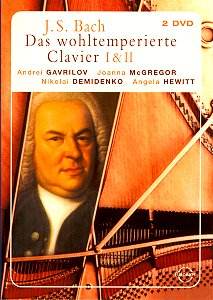The idea behind this
DVD release is simple but quite brilliant.
In 2000, to mark the 250th
anniversary of Bach’s death, the BBC
engaged four top international pianists
of similar age and who all happen to
reside in England, to play 12 each of
the 48 Preludes and Fugues. These were
to be filmed in different locations,
from exotic Venice and Barcelona to
good old Walsall in the Midlands. Some
were broadcast in tiny chunks on BBC
4, and now the whole lot is together
on a double DVD pack. The concept was
obviously to try and make the 48 interesting
to look at as well as listen to, and
whatever your views on watching music
being performed on TV, the results here
are as engaging as any I’ve come across.
This has much to do
with the quality of the playing, but
imaginative camerawork and lighting
do play a big part. The general concept
is to adopt a number of ‘filmic’ approaches
to each prelude and fugue that alternate
throughout both sets. These vary between
starting with a close-up of the hands
and then shifting away and panning around
the piano, or starting from a distance
(sometimes actually outside) and then
slowly closing in to the piano. Within
these bounds are a few variants, but
the formula is pretty constant through
the four-plus hours of the discs. The
lighting is subtly altered to accompany
the camerawork, from bright daytime
to candlelit night. The artists also
change clothes to match this, alternating
between concert black, fairly casual
(Hewitt’s colourful sweaters) and very
casual (Gavrilov in jeans and sweatshirt,
McGregor in black dress and trainers).
The overall result is something interesting
enough to be worth watching on the screen
but never distracting to the performances.
The pianos are also moved around within
the different venues, so the backdrops
and indeed acoustic, do shift in perspective.
The opulence of the Barcelona and Venetian
Palaces is nicely offset by the cool
austerity of the then newly–opened Walsall
Art Gallery, and the recorded sound
(engineered by Mike Hatch) is generally
excellent, even the most cavernous spaces
being tamed.
The performances are
also unlikely to disappoint. I suppose
the most ‘controversial’ is Gavrilov,
but only because he uses pedal and rubato
with a touch more freedom than the others.
I certainly have no problem with this
approach, which only seems to stem from
his Russian background and admiration
for the Bach playing of Richter and
Gilels. Personally, I prefer a piano
performance of this music to illuminate
me and show the extra dimension that
a modern concert grand can give. Anyway,
if you are irritated, you know another
pianist will take over before long.
McGregor is also well known for also
being a provocative Bach player and
she certainly attacks some of the preludes
with a vigour and abandon that have
you on the edge of your seat (try No.15
in G major, where she nearly comes unstuck).
Again, this is Bach pianism of a very
high order, making you hear phrases
afresh and bringing alive inner detail
that can seem as dry as dust.
Demidenko is less confrontational
than I expected. Like his fellow Russian,
he is aware of his roots, and produces
tingling preludes that glitter with
clarity, followed by fugues that grow
with an intensity and cumulative tension
that sweep one along. This is playing
it is impossible to switch off to. Hewitt,
beautifully filmed in Bach’s birthplace,
Eisenach, is probably the safest here,
but her credentials are so sound that
her set makes the perfect finale. This
playing is a model of good taste that
never becomes boring, where clarity
of line and texture is paramount, where
the instrument truly sings.
Talking of instruments,
the pianos are the other stars here.
Three are Steinway D concert grands,
with Demidenko on a Fazioli, presumably
because he’s in Italy. All are beautifully
regulated and voiced, with the Fazioli’s
extra bell-like clarity coming to the
fore in some of Demidenko’s scintillating
passagework. The only irritation (if
it bothers you) is that his section
of the film is interrupted at one point
for some shameless product-pushing,
as we see a piano (which just happens
to be a Fazioli) in various stages of
factory manufacture. Ah well, I suppose
they may have cut a deal with the hire
charge…
According to the booklet,
these films were not just to celebrate
Bach’s genius, but to be made in a way
that would ‘appeal to the general viewing
public who may not know much Bach …’
Given the high quality of the playing
and production values, this deserves
to succeed.
Tony Haywood







